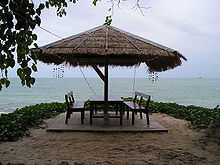Ko Samet


Ko Samet[1] (Thai: เกาะเสม็ด, Thai pronunciation: [kɔ̀ʔ samèt]), is one of the Eastern Seaboard Islands of Thailand. It is located in the Gulf of Thailand off the coastline of the Thai province of Rayong, approximately 220 kilometres (140 mi) southeast of Bangkok. Ko Samet is part of the Phe (Thai: เพ) Subdistrict of the Amphoe Mueang Rayong (Thai: เมืองระยอง, the capital district, or Amphoe Mueang), of Rayong province. Ko Samet is the largest and westernmost of a cluster of islands not far from the coast.[2]
Popular with foreign tourists and as a weekend getaway for residents of nearby Bangkok, most of the island (excluding the Na Dan area) belongs to the Khao Laem Ya - Mu Ko Samet National Park. In 1981, the Royal Forest Department declared the archipelago of Samet, along with nine other small islands, the headland of Khao Laem Ya, and the 11 kilometres (6.8 mi) Mae Ramphueng Beach to be a National Park, and is thus Ko Samet is under the protection of the National Parks Division of the Thai Government.
Ko Samet is 6.5 kilometres (4.0 mi) south of mainland Rayong province and is surrounded by the Gulf of Thailand.
History
The Thai government restricted overnight stay on the island until 1981 (even though Bangkokians had known about the beauty of Ko Samet for decades before). In that year, on 1 October, the Forestry Department of Thailand declared Ko Samet and its surrounding to be a national park.
Geography and climate
Located just 220 km from the capital in the Gulf of Thailand, Ko Samet is approximately 13.1 square kilometres (5.1 sq mi) in size, and shaped somewhat like a letter "t". Along the length of the "t" (north-south) the island measures approximately 7 km, and measures 4 km across the "t" (west-east). Forest remains blanket up to 80% of the total area.[citation needed]
Closest to the Rayong coast, lies the small island port village of Na Dan, commonly known as Ko Samet Village, with its nearby beach Hat Sai Kaeo (Thai: หาดทรายแก้ว), the longest beach on Ko Samet. Most of Ko Samet's beaches lie along the eastern shore of the island. Other beaches on the island include: Ao Phai, Ao Wai, Ao Kio Na Nai, Ao Cho, Ao Kio Na Nok, Ao Wong Duean, Cape Kut, Ao Toei, and Ao Karang at the southern tip, and Ao Phrao on the western shore of the island. Just off the southern tip of the island are three small rock-islands, Ko Chan (Moon Island; Thai: เกาะจันทร์), Ko San Chalam (Shark Fin Island), and Hin Khao (White Rock; Thai: เกาะหินขาว).
Ko Samet is one of the driest archipelagos in Thailand. Ko Samet gets significantly less rainfall than Rayong Province, even though it is only a few kilometres offshore. The island's "rainy season" extends only from May to July, but even during this season it has less rain that other islands in Thailand. The island despite being arid, consists of lush forested hills, covered with evergreen and deciduous forest and cajeput trees grow abundantly. Owing to the lack of rain, Ko Samet still ships in potable water to the island.
Administration
Ko Samet is under the administration of Phe Subdistrict, Mueang District, Rayong Province. Ko Samet is also under the National park area (Khao Laem Ya - Mu Ko Samet National Park)
Transportation
There are 2 main routes on Ko Samet.
- Northern route connects Hat Sai Kaeo to Ao Klang and Ao Noina.
- Central route consists of 4 smaller roads. The first road links Sai Kaeo beach to Ao Phai and Ao Phutsa. The second road connects the center of island to Ao Wong Duean. The third road connects the first road to Ao Thapthim and Ao Nuan. The fourth road connects the first road to Ao Phrao.
Public transportation includes the use of Songthaew (public passenger pick-up vehicles)
There are 5 piers: Ao Klang, Ao Phrao, Ao Wong Duean, Ao Thian and Ao Wai. Ao Klang Pier is the port to mainland. The rest are piers for diving and excursions.
In popular culture

During the 19th century the poet Sunthorn Phu (1786–1855), set part of his epic work, Phra Aphai Mani (sometimes transliterated as Pra Apaimanee), on the shores of the island.[3] Statues of the title character, Prince Aphai Mani and the siren/mermaid which guided him to Ko Samet can be found on the Hat Sai Kaeo beach.
See also
Notes and references
- ↑ Alternately transliterated as Koh Samed or Ko Samed or Koh Samet
- ↑ Islands of the Ko Samet group
- ↑ Cummings, Joe (2005). Thailand. Lonely Planet. p. 249. ISBN 1-74059-697-8.
External links
| Wikimedia Commons has media related to Ko Samet. |
-
 Ko Samet travel guide from Wikivoyage
Ko Samet travel guide from Wikivoyage - Khao Laem Ya - Mu Ko Samet National Park
Coordinates: 12°34′4″N 101°27′17″E / 12.56778°N 101.45472°E